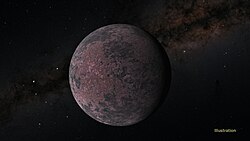Astronomy:GJ 1252
| Observation data Equinox J2000.0]] (ICRS) | |
|---|---|
| Constellation | Telescopium[1] |
| Right ascension | 20h 27m 42.08140s[2] |
| Declination | −56° 27′ 25.1519″[2] |
| Apparent magnitude (V) | 12.193[3] |
| Characteristics | |
| Evolutionary stage | Main sequence |
| Spectral type | M2.5V[4] |
| Apparent magnitude (B) | 13.655±0.029[3] |
| Apparent magnitude (V) | 12.193±0.056[3] |
| Apparent magnitude (G) | 11.235±0.003[2] |
| Apparent magnitude (J) | 8.697±0.019[3] |
| Apparent magnitude (H) | 8.161±0.034[3] |
| Apparent magnitude (K) | 7.915±0.023[3] |
| Astrometry | |
| Radial velocity (Rv) | 7.38±0.29[2] km/s |
| Proper motion (μ) | RA: 424.417[2] mas/yr Dec.: −1,230.941[2] mas/yr |
| Parallax (π) | 49.0555 ± 0.0247[2] mas |
| Distance | 66.49 ± 0.03 ly (20.39 ± 0.01 pc) |
| Details[3] | |
| Mass | 0.381±0.019 M☉ |
| Radius | 0.391±0.020 R☉ |
| Luminosity (bolometric) | 0.0196+0.0026 −0.0023 L☉ |
| Surface gravity (log g) | 4.49[2] cgs |
| Temperature | 3,458+140 −133 K |
| Metallicity [Fe/H] | 0.1±0.1 dex |
| Age | 3.9±0.4[5] Gyr |
| Other designations | |
| Database references | |
| SIMBAD | data |
GJ 1252 is a red dwarf star located 66.5 light-years (20.4 parsecs) away from the Solar System in the constellation of Telescopium. The star has about 38% the mass and 39% the radius of the Sun, and a temperature of about 3,458 K (3,185 °C; 5,765 °F). GJ 1252 is orbited by one known exoplanet.[3]
Planetary system

GJ 1252 was found to have a planet, GJ 1252 b, in 2019 using transit observations from TESS.[3] It is a terrestrial planet larger than Earth, with about 1.3 times the mass and 1.18 times the radius of Earth. Orbiting its star with a very short period of just 12.4 hours, it is presumably tidally locked. Secondary eclipse observations have shown that GJ 1252 b lacks a significant atmosphere, similar to LHS 3844 b and TRAPPIST-1b, and have measured its dayside temperature at about 1,410 K (1,140 °C; 2,080 °F).[5][7]
| Companion (in order from star) |
Mass | Semimajor axis (AU) |
Orbital period (days) |
Eccentricity | Inclination | Radius |
|---|---|---|---|---|---|---|
| b | 1.32±0.28 M⊕ | 0.00915±0.00015 | 0.51824160 | — | 84.8±3.2° | 1.180±0.078 R⊕ |
References
- ↑ "Finding the constellation which contains given sky coordinates". 2 August 2008. http://djm.cc/constellation.html.
- ↑ 2.0 2.1 2.2 2.3 2.4 2.5 2.6 Vallenari, A. et al. (2022). "Gaia Data Release 3. Summary of the content and survey properties". Astronomy & Astrophysics. doi:10.1051/0004-6361/202243940 Gaia DR3 record for this source at VizieR.
- ↑ 3.0 3.1 3.2 3.3 3.4 3.5 3.6 3.7 3.8 Shporer, Avi et al. (February 2020). "GJ 1252 b: A 1.2 R⊕ Planet Transiting an M3 Dwarf at 20.4 pc". The Astrophysical Journal Letters 890 (1): L7. doi:10.3847/2041-8213/ab7020. Bibcode: 2020ApJ...890L...7S.
- ↑ Reid, I. Neill et al. (October 1995). "The Palomar/MSU Nearby-Star Spectroscopic Survey. I. The Northern M Dwarfs -Bandstrengths and Kinematics". Astronomical Journal 110: 1838. doi:10.1086/117655. Bibcode: 1995AJ....110.1838R.
- ↑ 5.0 5.1 5.2 Crossfield, Ian J. M. et al. (September 2022). "GJ 1252b: A Hot Terrestrial Super-Earth with No Atmosphere". The Astrophysical Journal Letters 937 (1): L17. doi:10.3847/2041-8213/ac886b. Bibcode: 2022ApJ...937L..17C.
- ↑ "GJ 1252". SIMBAD. Centre de données astronomiques de Strasbourg. http://simbad.u-strasbg.fr/simbad/sim-basic?Ident=GJ+1252.
- ↑ 7.0 7.1 Gohd, Chelsea (11 October 2022). "Discovery Alert: Ultra-hot 'Super-Earth' Could Have No Atmosphere". NASA. https://exoplanets.nasa.gov/news/1713/discovery-alert-ultra-hot-super-earth-could-have-no-atmosphere/.
 |

